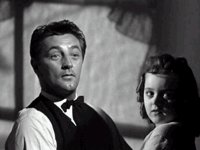Is It Really a Great Movie? Part Twenty-Three: The Night of the Hunter
by dan heaton
Using Roger Ebert's Great Movies book as a guide, this series of articles will focus on all films included on his list that previously have escaped my notice. Since all lists are subjective, I am not treating Ebert's choices as the essential selection of films. However, his essays offer the perfect chance for me to explore both classics and lesser-known pictures from around the globe.

Charles Laughton enjoyed a lengthy stage and film acting career of more than 30 years, and he finally decided to try directing in 1955. He chose The Night of the Hunter, an eerie adaptation of the David Grubb novel, and was so frustrated by the experience that he vowed to never direct again. The critical and audience reaction was not positive following the initial release, but the Gothic yarn has garnered tremendous acclaim since that time. Much of the praise focuses on star Robert Mitchum, who called the role of Harry Powell one of his all-time favorites. This film was awarded the #34 slot on AFI’s “100 Years, 100 Thrills” list; and Powell earned the #29 slot on their top villains ranking. However, its expressionistic style still divides viewers who aren’t sure what to make of this odd little movie.
Can a single performance elevate a film to Great Movie status? Mitchum’s work as Harry Powell is one of the more chilling performances in film history. The false preacher journeys the country and murders for money while spouting moralistic platitudes. Wearing tattoos with “love” and “hate” on each corresponding palm, he rails against the sinners in the culture and can barely contain his rage while viewing an exotic dancer. While doing brief time in jail for stealing a car, he meets Ben Harper (Peter Graves), who faces capital punishment for murder. Harry quickly learns that his doomed cellmate hid $10,000 somewhere at his house. Following the logic of any sociopath, he decides to woo Graves’ widow Willa (Shelley Winters) and marry her to acquire the money. But complications ensue when her kids discover Harry’s devious plan and try to flee from his violent wrath. Laughton plays up the villain’s devilish nature and shoots his looming shadow in monstrous fashion. Mitchum acts especially creepy and even chills when he supposedly is acting charming. This is not the type of role that Carey Grant or Jimmy Stewart could play.
Unfortunately, Mitchum’s performance exists within a maddening plot that includes numerous hokey scenes. One of the goofiest moments occurs on Willa and Harry’s wedding night, which quickly shifts from happiness into ridiculous behavior. Her response to his personality change feels ludicrous and does not match her past actions. Critics have hailed this picture’s expressionistic style, but I found it mostly uneven and awkward. Harry acts like a crazed lunatic during the entire picture, but nearly everyone seems charmed by his presence. The daughter Pearl even returns for a hug several times after he threatens their lives. She is pretty young, but even a girl of her age would realize that Harry might not be father material. Also clunky are the townspeople, which resemble far too many clichéd ‘50s citizens. Their attitude shifts considerably with barely a moment’s notice and resembles something out of the mobs on The Simpsons. One exception is Lilian Gish’s Rachel Cooper, a strong older woman who stands up to Harry and easily sees through his obvious façade. Her tender caring for the children and final confrontation with him energizes the story during its concluding act.
Even considering the bumpy plot, this film is often entertaining due to some inventive direction and Mitchum’s unpredictable performance. Laughton also uses sound effectively to convey danger, with Harry’s calm singing inducing chills from a considerable distance. This device figures well in the end as Rachel’s proud singing contrasts nicely with Harry’s incoming menace. These scenes reveal the reasons for the high regard for this picture from many film lovers. I understand the reasons for its acclaim, but still can’t share in the unflinching praise. Film critic James Agee adapted the screenplay and crafted numerous memorable lines, especially Harry’s famed “left hand/right hand” monologue. However, the writer struggles to develop a convincing plot and must drag out the story to even reach the 90-minute running time. The supporting characters, particularly the rebellious teenager Ruby (Gloria Castillo), don’t hold our interest and only distract while we wait for Harry to return. Agee apparently wrote an extremely long first draft, which might explain the disjointed nature of the final product. Laughton assisted considerably with the cuts, and later claimed to have completely re-written the picture, but that idea appears untrue. The production was reportedly not copacetic, which might also give a reason for the movie’s irregular tone.
In his review of Night of the Hunter, Roger Ebert exclaims, “what a compelling, frightening and beautiful film it is!” I agree that certain scenes are disturbing and some shots are very impressive, but calling it one of the greatest American films feels like a stretch. I cannot disparage Mitchum’s stunning performance, but the utter lunacy of certain scenes and far too many dry spots keep this film from becoming a classic. It is a unique creation and worth a viewing, but does contain some major flaws. While Ebert decries the lack of recognition, I feel that Night of the Hunter receives too much credit. Although it remains enjoyable, this is one of the series’ biggest disappointments.
Copyright (c) 2007 erasing clouds |
|